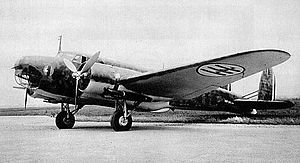| BR.20 Cicogna | |
|---|---|
 A Fiat BR.20 on the ground just prior to Italy's declaration of war in 1940. | |
| General information | |
| Type | Medium bomber |
| Manufacturer | Fiat |
| Designer | |
| Primary users | Regia Aeronautica |
| Number built | Fiat BR.20 (233)[1] Fiat BR.20M (279)[2] |
| History | |
| Introduction date | 1936 |
| First flight | 10 February 1936 |
| Retired | 1945 |
The Fiat BR.20 Cicogna ('stork') was a low-wing twin-engine medium bomber that was developed and manufactured by Italian aircraft company Fiat. It holds the distinction of being the first all-metal Italian bomber to enter service;[3] at the time, it was regarded as one of the most modern medium bombers in the world.[4]
The BR.20 has its origins in a request by the Regia Aeronautica (Italian Royal Air Force) issued during 1934 for a new medium bomber capable of high speeds, long range, and satisfactory payload, reliability, and flight characteristics compared to contemporaries. Among the companies that chose to respond was Fiat, which completed its design for the competition during 1935. On 10 February 1936, the first prototype (serial number M.M.274) conducted its maiden flight. Flight testing proceeded at a rapid pace; during September 1936, initial deliveries of the type commenced to the Regia Aeronautica.
During summer 1937, the BR.20 received its baptism of fire when a number were operated by the Aviazione Legionaria during the Spanish Civil War; the BR-20 came to form the backbone of Nationalist bombing operations, along with the German-built Heinkel He 111.[5] It was also used in combat during the 1930s with relative success by the licence built[6] Japanese examples during the Second Sino-Japanese War.[7] During 1939, a modified long-range BR.20 version (designated BR.20L) named Santo Francesco under the command of Maner Lualdi performed a highly publicised non-stop flight from Rome to Addis Ababa, Ethiopia.
Upon the entry of Italy into the Second World War during mid-1940, the BR.20 served as the standard medium bomber of the Regia Aeronautica, however, by that point, the type was already approaching obsolescence. By 1942, the aircraft was mostly used for maritime patrol and operational training for bomber crews.[7] The BR.20 was produced from the mid-1930s until the end of the Second World War. More than 500 were produced before the end of the war.[8]
- ^ Fiat BR cicognaalieuomini.it Archived 2014-09-26 at the Wayback Machine
- ^ Fiat BR cicognaalieuomini.it Archived 2014-09-27 at the Wayback Machine
- ^ Bignozzi, p. 10.
- ^ Gunston 1994, p. 221.
- ^ Ethell 1995, p. 66.
- ^ Munson 1960, p. 18.
- ^ a b Ethell 1995, p. 67.
- ^ Matricardi 2006, p. 257.